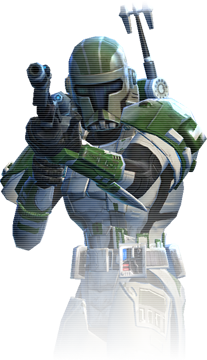
Development Thread: None. This uses the concept behind a Sound dampening overlay, Sonic dampening helmet, Sound dampening belt, Sound sponge, Stygian-tripismatic polymer, and other sound dampening tech and presents a multitude of drawbacks and limitations that should provide for effective counters to this armor, which should ultimately make non-Force users think twice before committing to sonic weaponry.
Manufacturer: Republic Department of War
Model: AS-01 Vindicator Armor
Affiliation: Galactic Republic
Modularity: None
Production: Minor-production, exclusive to player-characters
Material: Stygian-tripismatic polymer
Classification: Multipurpose
Weight: 22 kg
Quality: Heavy armor (Read description)
Description:
In 836 ABY, the Galactic Republic Center of Statistics made a note of the increase of sonic weaponry in the galaxy. Despite the low numbers of Jedi and trained Force-users, it seemed as if there was a gradual abandonment of blaster technology by certain groups in favor of sonic weapons - which countered a lightsaber. The Republic Department of War sought to exploit this paradigm shift.
Thus, the Republic developed the AS-01 Vindicator Armor. The purpose of this armor was to mitigate the damage that sonic weapons did to Republic troops. This involved the use of the natural sound dampening properties of the type of duraplast polymer used for the armor and combining it with the effect of a powerful sound dampening overlay.
The Vindicator Armor performed well for its purpose. Personal sonic arms failed to have a lethal effect on the armor for the first shot. Yet for each subsequent shot, the sound dampening overlay became increasingly taxed. No matter what, the armor could not take more than five sonic weapon shots within minutes of each other before the sound dampening overlay broke. Not only that, but the sound energy ended up becoming kinetic energy upon impact. A sufficiently powerful sonic rifle could still knock back a trooper wearing Vindicator Armor. Also, the armor could not withstand shots of mounted sonic weaponry. The armor could also easily withstand the stunning effects of sonic weaponry so long as the sound dampening overlay was not broken.
The size of the Vindicator Armor helped in its performance. The armor also required an armored backpack to carry the sensitive equipment and power cells required for the sound dampening overlay. This meant that only physically fit men and women could wear the armor. It also means that prolonged runs were more exhausting than with lighter armor. However, the developers of the armor believed that it was an acceptable sacrifice due to the low range of sonic weaponry compared to blasters.
Due to the nature of the sound dampening overlay for the Vindicator Armor, the residual interference of a lightsaber's containment field made the sound dampener ineffective. This meant that those wielding a lightsaber could not use the sound dampening properties of the Vindicator Armor. This was a design flaw that engineers on the Vindicator Project could not remedy.
One other fault of the Vindicator Armor was that it dampened most soundwaves - making it hard for the user to hear regular sounds. A control device on the wrist allowed for some sounds to be played in the helmet's speakers. Yet, it automatically switched off once sound became too loud, so someone yelling might accidentally adversely affect a Vindicator Armor user's hearing.
Another requirement of the Vindicator Armor was that the user had to wear the complete set. One could not wear just the body armor and not the helmet.
EMP devices also could easily disable the sound dampening systems. Users of the Vindicator Armor were advised to avoid confrontation with those that used such weapons.
The Vindicator Armor sported a typical heads-up-display that showed life signs of the user, distance to target, among other information. The helmet's lenses were also polarized. The helmet also allowed for the user to switch between normal and infrared vision. It also had a microphone and speaker system that allowed for the user to speak via comm to command and fellow squadmates. An annunciator in the helmet allowed for the user to speak to those not able to converse via comm.
The armor also sported a coolant system to keep the user from overheating. It also had an air filtration system by default, yet could also be equipped to have an air-tight oxygen supply system. The armor also had a catheter.
Despite being heavy armor, blaster bolts and slug throwers could easily be lethal with the first direct hit. Light arms could be resisted for a time, yet military grade arms could down a user of Vindicator Armor with ease. If a direct hit from a blaster or slug thrower still left the user of the armor alive, the sound dampening properties of the armor would have been severely diminished.
It has been noted that the most effective use of this armor was when the user was paired with a Jedi. The ability for the Jedi's lightsaber to block blaster fire coupled with the user of Vindicator Armor able to more easily neutralize sonic weapon users synergized well with each other and covered for each combatants' weaknesses. They would just have to keep in mind not to fight less than a meter from each other or less the lightsaber would disable the sound dampening overlay.



